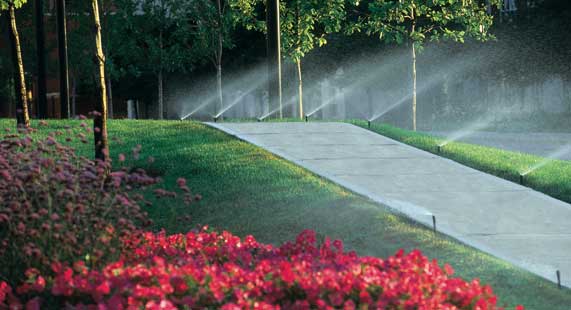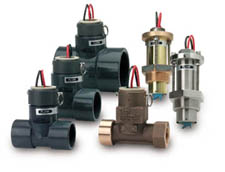
 |
Backflow Prevention |
Backflow Prevention and Municipal Regulations
The majority of sprinkler irrigation systems in B.C. are connected to a potable (safe for drinking) water supply. This potable water supply could consist of a city water main, a well, or any other source of drinking water supplied by your local water purveyor. The connection of a sprinkler irrigation system, with its maze of pipes, valves, and sprinkler heads to a potable water supply, is called a cross connection.
Herbicides, pesticides, fertilizers or animal feces may collect in cesspools of water around the sprinkler heads, creating a potential for the contaminants to be drawn back through the sprinkler irrigation system. This flow of contaminates (by means of Backflow or Backsiphonage) into the potable water supply line, without an approved means of cross connection control, will result in contamination of potable water supply.
- What is Potable Water?
- What is a Cross Connection?
- What is Backflow?
- What is Backsiphonage?
- Why do I need Cross Connection Control on my Sprinkler Irrigation System?
- Why do I need my "Backflow Prevention Assembly" tested annually?
- What are the local bylaws, and how do I test my Backflow Preventer (BFP)?
Potable Water is water which is safe for human consumption, free from harmful or objectionable materials, as described by the health authority.
 A cross connection is any actual or potential physical connection between a a potable water line and any pipe, vessel, or machine containing a non-potable fluid, or has the possibility of containing a non-potable fluid, such that it is possible for the non-potable fluid to enter the water system by backflow. A cross connection could be any physical arrangement whereby a potable water supply is connected directly or indirectly with any non-potable or unapproved water supply system, sewer, drain, conduit, pool, storage reservoir, plumbing fixture, or any other device which contains, or may contain, contaminated water, liquid, gases, sewage, or other water of unknown or unsafe quality which may be capable of imparting contamination to the potable water supply as a result of backflow.
A cross connection is any actual or potential physical connection between a a potable water line and any pipe, vessel, or machine containing a non-potable fluid, or has the possibility of containing a non-potable fluid, such that it is possible for the non-potable fluid to enter the water system by backflow. A cross connection could be any physical arrangement whereby a potable water supply is connected directly or indirectly with any non-potable or unapproved water supply system, sewer, drain, conduit, pool, storage reservoir, plumbing fixture, or any other device which contains, or may contain, contaminated water, liquid, gases, sewage, or other water of unknown or unsafe quality which may be capable of imparting contamination to the potable water supply as a result of backflow.
Backflow is the flow of water or other liquids, gases, or solids from any source back into the customers plumbing system of the water purveyor's water distribution system.
What Is Backsiphonage?Backsiphonage is backflow due to a negative or reduced pressure within the purveyor's potable water supply.
Why do I need Cross Connection Control on my Sprinkler Irrigation System?Everyone likes to feel that the potable water supply is safer and under control at all times. Unfortunately, this is not always true, and precautions are required to ensure the health and safety of all British Columbians. It is a very real and constant danger that our potable water supply could become contaminated by something harmful to our health. As a result, minor skin irritation, serious health effects, or in some cases death may occur. For this reason, backflow preventers should be selected, installed, maintained and field tested in conformance with CSA B64.10 of the BC Building Code (Code 1998 Part 7.6.2.12.2 Backflow Preventers.)
It is up to your local water purveyor to specify which type of backflow preventer to use, as outlined in the Manual for Selection, Installation Maintenance and Field Testing of Backflow Prevention Devices. A Backflow Prevention Device (non testable) or Assembly (testable) are the most common.
Have your IIABC Certified Irrigation Contractor from University Sprinklers obtain all necessary permits and inspections on your sprinkler irrigation cross connection as required. Please do your part to ensure that everyone can enjoy the benefits of safe drinking water and ensure the health and safety of everyone in B.C.
Why do I need my "Backflow Prevention Assembly" tested annually?As with everything that is manufactured, Backflow Prevention Assemblies and Devices break or wear out. By having your Backflow Prevention Assembly tested annually, you will help to ensure that the potable water supply remains safe.
Certified Backflow Assembly Testers in BC attend a rigorous training course, and are certified by the American Waterworks Association, British Columbia Section. They are equipped with the latest in research from the University of Southern California, Foundation for Cross Connection Control and Hydraulic Research. Certified Testers can inspect, test, and repair all Backflow Prevention Assemblies and Devices.
What are the local bylaws, and how do I test my Backflow Preventer (BFP)?All municipalities in the GVRD have a law that all Backflow Preventers must be tested yearly. Some municipalities charge the homeowner for testing the BFP. Here's the rundown on which do and which don't:
- Burnaby - no charge
- Vancouver - charge
- Richmond - charge
- Delta - charge
- North Vancouver - no charge
- New Westminster - charge
- Maple Ridge - no charge
- Surrey - charge
- Coquitlam - no charge
- UEL - no charge
- City of Langlen - no charge
- Port Coquitlam - no charge
- Port Moody - charge
- Abbotsford - no charge
- West Vancouver - no charge
- White Rock - charge
Do your part and test your Backflow Preventer, to help ensure safe drinking water for all British Columbians!
Re-written with permission of the IIABC

© Copyright
University Sprinkler Systems Inc.
University Sprinklers and www.universitysprinklers.com are registered trademarks of University Sprinkler Systems Inc.
Website Design by Rainmaker Marketing & Design. 604-739-9476
